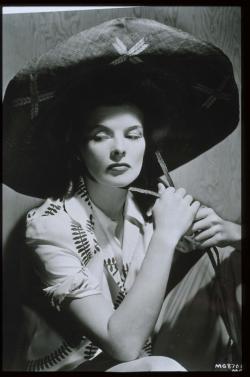The display case that first greets visitors to the “Katharine Hepburn: Dressed for Stage and Screen” exhibit at the New York Public Library for the Performing Arts contains seven pairs of the actress’s trousers, artfully arranged in a series of comfortable poses. On the day I worked my way through the show, I didn’t notice a single visitor sporting a skirt, but back in the 1930s, when Hepburn began her career, trouser-wearing women were a rare sight.
In Evelyn Waugh’s Vile Bodies, first published in 1930, the willful young Agatha Runcible is denied entry to a country hotel on account of her trousers: “[T]hey made Miss Runcible stay outside, and brought her cold lamb and pickles in the car,” Waugh writes. Even in the late 1950s and early ’60s, the title character in the lesbian pulp novels by Ann Bannon now known as “The Beebo Brinker Chronicles,” was forced to work as an elevator operator and delivering pizzas, since those were the only jobs that allowed her to wear pants.
The NYPL exhibit also includes a striking publicity shot taken on the RKO lot in 1932 that shows Hepburn in a mink coat and well-worn wide-legged blue jeans, an early example of the kind of high-low juxtaposition so celebrated today. When irritated studio heads took away her denim, Hepburn simply walked around the set in her underpants until they returned her dungarees. Director George Stevens said, “She was never personally much on ornamentation, off the camera. She Jimmy Deaned before Jimmy Dean ever thought of it, with slacks. … She wore blue jeans and it was unheard of, and a sweater, and she’s a grand dame of a studio.”
Other than the famous still of Hepburn in full drag as “Sylvester” in the 1935 movie Sylvia Scarlett, which graced many a lesbian’s dorm room wall in postcard form, and a couple of outfits from her later years, that’s about it for Katharine Hepburn the pants-wearer in this exhibit. But there’s much more to see. In fact, as with an exhibition that occupied the same space earlier this year, “Star Quality: The World of Noël Coward,” it’s the ordinary items that seem most fascinating.
The Hepburn show contains photos, posters, scrapbooks, press clippings, and, of course, clothes. But there’s also a note from a wardrobe attendant (“Your total professionalism, and the great care you took with the costumes, made my job a pleasure”); a letter from her favorite wig-making company, in London, which for some reason preferred to wait to send her latest purchase with someone heading to America rather than entrusting it in the mail; and, most fascinating of all (though it requires a time commitment to sit down and listen for more than a few moments), the audio of a long conversation between Hepburn and Louis Botto, a Playbill senior editor, who was working on a biography of costume designer Walter Plunkett, with whom she did 11 films.
In a city whose museums are stuffed with mind-blowingly expensive artifacts, these humble exhibitions make great artists like Coward and Hepburn seem like regular folks who just happen to be insanely talented and incredibly diligent. The kind of people whose trousers will one day draw a crowd.
